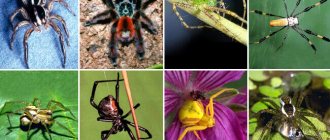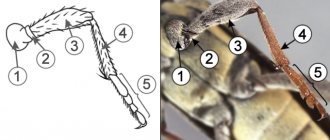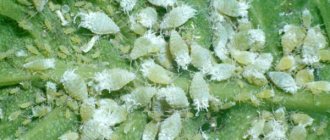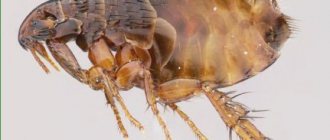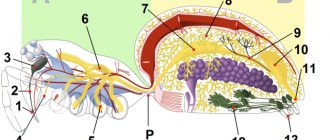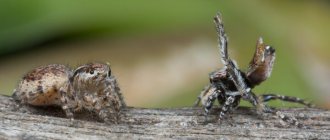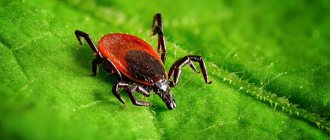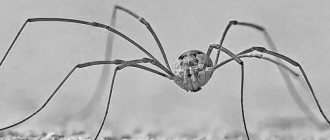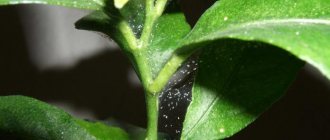The fauna of our planet is full of a huge number of living creatures that fascinate with their diversity, so it is often difficult to immediately determine what species an organism belongs to.
For example, not many people know that spiders belong to animals, a phylum of arthropods and a class of arachnids . There are more than 42 thousand species of spiders, of which 1.1 thousand are fossils.
Moreover, they can be found everywhere, even where no living creature can live. This article will take a detailed look at who spiders are and what they are.
Description of the spider
The spider is the most ancient creature on the planet. It is much older than humans; these organisms arose in advance. The remains of vital activity, spider webs, were discovered in the structure of amber, which is 100 million years old.
Arachnids lived on the globe back in the Paleozoic era, and this was 2.5 billion years ago. During this period, these creatures practically did not change in appearance.
To understand who spiders are, it is worth considering their features and description of their appearance. They have 6 pairs of limbs. However, the person notices 4 pairs. This is due to the fact that the first 4 limbs are transformed into organs of nutrition and touch.
General characteristics include the following appearance criteria:
- The body of arthropods is divided into two parts - the cephalothorax and abdomen. They are connected using a short jumper;
- the cephalothorax is divided by a groove into the head and thoracic parts;
- on the chest part there are the limbs of the spider, due to which it moves and weaves a web;
- on the surface of the head there are two pairs of limbs, eyes and a mouth opening.
The number of eyes may vary. Most arthropods have 8 visual organs. But in individuals living in the darkness of caves, they may be absent.
Classification of arachnids orders
The classification of arachnids includes more than ten orders. The following eight are of greatest importance: 1. Scorpions; 2. Telephons, or flagellated (Uropygi); 3. False scorpions (Pseudoscorpiones); 4. Solifugae; 5. Haymakers (Opiliones); 6. Spiders (Aranea); 7. Acariformes mites; 8. Parasitiformes.
Order Scorpions
Scorpions are common in southern latitudes. These are nocturnal predators. During the day they hide in burrows, under stones, under the bark of trees, and at night they go out hunting. The venom of large scorpions causes painful phenomena in humans not only of a local (tumor), but also of a general (headache, fever) nature. In some very rare cases, injections from large species of scorpions can lead to death. For the small animals that scorpions feed on (other aciformes, millipedes and insects), their injections are fatal.
There are about 600 species of scorpions. A small yellow Crimean scorpion (Euscorpius tauricus) lives in Crimea. It barely reaches a length of 40 mm. Caucasian scorpions are somewhat larger, for example, the Italian scorpion (Euscorpius italicus), found on the Black Sea coast of the Caucasus, or the motley scorpion (Buthus eupeus), common in Transcaucasia and Central Asia. Large scorpions live in the tropics; for example, the African scorpion (Pandinus imperator) reaches 18 cm in length.
Order Telifona, or Flaglegs (Uropygi)
Telifons are tropical predators, somewhat similar to scorpions, with highly developed grasping pedipalps. The front legs are long, rope-like, replacing antennae. The abdomen is strongly dissected (11 segments), the last three segments form a stalk ending in a long segmented caudal filament. There is no poison gland. They breathe with their lungs (2 pairs).
Widely distributed in the tropics. We have one species in the Ussuri region - the Amur thelyphon (Thelyphonus amurensis).
Order False scorpions (Pseudoscorpiones)
False scorpions are small predatory animals that look somewhat similar to real scorpions. The similarity with scorpions is manifested in the shape of the pedipalps, ending in powerful claws with which they catch prey. The strongly developed, wide, segmented abdomen (11 segments) does not carry a sting with a poisonous gland at the end. Pseudoscorpions have arachnoid glands that open at the end of the chelicerae. They breathe only through tracheas, there are no lungs.
False scorpions live under stones, under the bark of trees, and feed on small insects. An interesting book false scorpion (Chelifer cancroides), which lives in bookcases and books, in collections and herbariums. It does not harm books or collections. By destroying insects harmful to libraries, it is rather useful, but the very presence of these animals among the books indicates the presence in the library of some kind of book pests that serve as food for the book false scorpion.
Order Solifugae
Salpugs are fairly large predatory arachnids (some species reach 10 cm in length) and live in southern latitudes. In Russia, salpugs are common in the Azov and Caspian steppes, in Central Asia, the Crimea and the Caucasus. In the Crimea and the Caucasus, the phalanx (Galeodes araneoides) (about 5 cm in length) is common. Salpugs are easy to distinguish from other arachnids by powerful claw-shaped, but not venom-bearing, chelicerae, but pedipalps, similar to highly developed walking legs, as a result of which salpugs give the impression of decapods, and by two free thoracic segments. Salpugs breathe through tracheas.
Although salpugs are not poisonous, however, when they bite through human skin with chelicerae, they contaminate the wound, which can cause an inflammatory process.
Order Harvesters (Opiliones)
Many people know haymakers by their very thin and long walking legs, which easily come off (autotomy) and at the same time retain the ability for convulsive movements. Hence the name “haymaker”. Harvesters are very different from real spiders, despite some external similarities with them. They have small, claw-shaped chelicerae that do not have venom glands. The dismembered abdomen is not separated from the cephalothorax by a deep constriction, like in spiders.
Harvesters do not have lungs, and they breathe through highly developed tracheas. Harvesters can be found on tree trunks, on the walls of houses, sheds, under leaves and in houses, where they hunt for small insects.
Classification of arachnids Order Spiders (Aranea)
Spiders are one of the most numerous orders of arachnids (about 21,000 species), they can be found in a wide variety of environments: in forests and fields, in gardens and houses, and even in water.
The order of spiders is divided into three suborders: 1. Arthroplasty spiders (Liphistiomorphae); 2. Mygalomorph spiders, or tarantula spiders (My galomorphae); 3. Araneomorphae spiders (Araneomorphae).
The first suborder includes only 8 species of the most primitive tropical spiders with a dissected abdomen. Representatives of the second suborder are the largest spiders in the world, sometimes reaching 10 cm in length. The suborder includes about 1,500 species, which are distributed mainly in hot countries and of which only a few are found in our fauna. These are the Central Asian Nemesia sauvagei and others - inhabitants of peculiar hunting burrows. In the steppes, the digger spider (Atypus piceus) is common, which makes long catching tubes from its web, protruding far beyond the flaw. The same group includes the large South American tarantula spider and the even larger (up to 9 cm in length) Javan tarantula spider. The first two suborders of spiders are sometimes combined into the group of four-legged spiders, since they have two pairs of lungs, while the third suborder includes two-legged forms.
Two-lunged spiders have one pair of lungs and, in addition, tracheas. Almost all spiders found in Russia belong to this suborder. Typical representatives are the cross spider (Araneus diadematus), house spider (Tegenaria domestica), tarantula (Lycosa singoriensis), karakurt (Latrodectus tredecimguttatus), silver water spider (Argyroneta aquatica), etc. In the biology of spiders, the most characteristic feature is the formation and spinning webs that have a variety of purposes. We know that the abdomen of spiders often contains a very large number of arachnoid glands, the excretory ducts of which end in holes at the ends of the smallest chitinous tubes sitting on the arachnoid warts. These glands differ in their structure (tubular, pear-shaped, vesicular, etc.) and in the secretion they secrete. Apparently, different types of webs formed by spiders and having various uses are secreted by different glands.
The web is used by a significant part of spiders, called tenet spiders (house spider, cross spider, etc.) to build trapping nets into which prey gets caught and entangled.
The web of a cross spider can serve as an example of a very complex design. It must be borne in mind that an individual arachnoid thread is a product of the secretion of several, often many, glands. Each gland secretes a liquid substance that instantly solidifies in the air into a thin thread. From these the spider spins web threads. Each thread consists of several sticky webs. The spiral threads of the cross spider are sticky. The sticky substance covering them is secreted by tree-like glands. The spider sits, lying in wait for prey, outside its hunting net, hiding in a secluded place near one of the radial threads. It is connected to the hunting web by a special signal web thread. Thanks to the signal thread, the spider senses the slightest vibrations of the net. As soon as the prey has fallen into the net, the spider pounces on it, strikes it with its chelicerae and entangles it with a special web secreted by it at this time.
The spinning of webs and the construction of hunting nets are carried out by the spider using the last segments of its walking legs, especially the legs of the hind pair. The last segment of the posterior pair of legs has special comb-like claws.
The web is used by spiders not only for the construction of hunting nets. Female spiders weave webs around the eggs they lay and make cocoons around them. Some spiders wrap tree leaves on which eggs are laid and also weave webs around them. Burrowing spiders line their home with webs—usually a shallow burrow dug in the ground, often on the bank of a river. The males of some spiders make something like a small hammock out of their web, into which they release sperm, which is then collected in the copulatory appendages of the pedipalps.
Of particular interest is the use of webs by young spiders of many species in early autumn (“Indian summer”) as a flight web. Having climbed the stem of a plant or the end of a branch, the spider releases a web, attaching its end to the branch. When the web is long enough, the spider breaks it off at the point of attachment. After this, it continues to secrete the web for some time, and then draws in its legs and breaks away from the plant, carried away by the web in the wind. The flight web is an interesting adaptation that ensures the dispersal of the species.
Are spiders harmful or beneficial? Since they are predators, destroying mostly harmful insects - flies, mosquitoes, etc. - they, like other arachnids, with the exception of ticks, should be considered useful animals. The fear and hostility they inspire (for residents of middle and northern latitudes) have no basis. The bites of some spiders, although painful, such as tarantula bites, do not pose any serious danger. On the territory of Russia, only the karakurt, found in the Caucasus and Central Asia, is very dangerous for animals and humans. The distinctive features of the karakurt are as follows: the spider is small in size (about 1.5 cm), has a black abdomen covered with small red spots. Lives on the ground, among stones, creating sparse nets that creep along the ground. Karakurt bites are often fatal. Horses, cattle and especially camels die from them. However, sheep are not sensitive to karakurt bites. Therefore, flocks of sheep are sometimes driven to areas inhabited by karakurts, and the sheep trample down spiders and their nests. In humans, karakurt bites cause a severe painful condition, sometimes fatal.
Order Acariformes and order Parasitiformes
Ticks are a collective group that unites two (according to some sources three) independent orders: 1. Acariformes and 2. Parasitiformes.
Ticks are a very large and practically important group of arachnids. Many of them are of great medical and veterinary importance as ectoparasites of humans and animals. They are capable of storing and transmitting pathogens of a number of serious diseases from animals to humans for a long time and can themselves cause diseases by parasitizing the skin of humans and domestic animals. Some mites serve as intermediate hosts for tapeworms. The harmful activity of ticks is also very significant in economic terms. Many groups of mites destroy and spoil grain and flour reserves and parasitize cultivated plants, causing their weakening or death.
Of all arachnids, mites are the smallest animals, often microscopic in size (0.1-05 mm, rarely up to 15 mm). Their organization deviates greatly from the typical arachnid pattern.
The order of acariform mites is the most numerous, it includes more than 6,000 species, among which there are very primitive forms with a dissected cephalothorax, like a salpugs, and a segmented abdomen.
In the most primitive mites, there is a fusion of head segments bearing chelicerae, pedipalps and two pairs of limbs, and the separation of a trunk section, which combines free thoracic segments with two pairs of limbs and a jointed abdomen. Others, like most arachnids, have a cephalothorax bearing six pairs of limbs. However, in many mites, not only body segments, but also its parts merge into a total mass.
In the order of parasitiform mites, segmentation has not been preserved. It includes about 4,000 species, among which there are many parasites that carry pathogens of various infections.
Not all ticks are parasitic on animals and humans. The diversity of habitats and lifestyle of this huge group of arachnids is surprising. Among them are a mass of saprophages that feed on decaying organic remains, herbivorous forms, predators and, finally, various parasites of both vertebrate and invertebrate animals.
Due to different feeding methods and lifestyle characteristics, the chelicerae and pedipalps are greatly modified and are part of a complex “head” (gnathema). In carnivorous and heterovorous forms, the chelicerae bear claws, forming a gnawing-sucking mouthparts. Parasites and herbivorous mites have a piercing-sucking type of mouthparts, and in the former it provides not only a puncture of the host’s tissues, but also a long-term fixation on it. A complexly structured proboscis appears, carrying a kind of anchor device - a hypostome, seated with hooks directed backwards.
Ticks breathe through tracheas, and small forms are characterized by cutaneous respiration.
Postembryonic development of mites, unlike other arachnids, occurs with metamorphosis. A larva emerges from the egg, having, instead of four, only three pairs of walking legs. The larva turns into a so-called nymph, which already has 4 pairs of legs and after one to three molts it turns into an adult tick. The nymphal stage of some ticks can be nonmotile, resembling the pupal stage of insects. In different groups of ticks, metamorphosis occurs differently; the number of nymphal stages may increase or, conversely, decrease, up to viviparity.
Among ticks inhabiting various habitats, natural groups arise, the most important of which we should consider. In ponds and lakes, fairly large, quickly swimming in the water, brightly colored water mites, or hydracarids, are common. However, only in adulthood do they lead a free lifestyle. feeding on crustaceans and insect larvae. Their larvae lead a parasitic life on various aquatic insects and their larvae (aquatic bugs, dragonflies, etc.). When insects fly out of a reservoir, the water mites that parasitize them are dispersed.
Many groups of mites inhabit the soil, being its founders and ancient aborigines. The largest group of soil mites are oribatei mites, named for their characteristic hard shell. making them resistant to changes in external conditions, increasing their durability, and also promoting settlement. Some oribatid mites develop wing-like projections on the sides of their bodies—pteromorphs. The latter can even articulate movably, and the so-called winged mites wave them when moving. It is believed that these formations are similar to the lateral outgrowths of the chest of ancient insects, from which wings apparently developed. Acarologists (mite specialists) jokingly declare that oribatid mites are about to fly. This can be seen as an example of the convergent formation of wing analogues in arachnids.
Oribati mites are typical saprophages, eating various decaying organic remains, including animal droppings. At the same time, they can swallow the eggs of tapeworms Moniezia expansa and others. More than 50 species of oribatid mites serve as intermediate hosts of tapeworms. In ticks, embryos develop and cysticercoids form. Sheep and other domestic and wild ungulates become infected with moniesiosis by eating ticks containing helminth larvae along with grass.
A particularly important group from a practical point of view are various blood-sucking ticks, since when they attack animals and humans, they not only cause irritation and itching, but also carry pathogens of various, sometimes very dangerous, diseases. Blood-sucking ticks are represented by the superfamily of ixodid ticks (Ixodoidea) (from the order Parasitiformes), which includes the largest species of all ticks. Well-fed females reach sizes of more than 15-20 mm.
Of the blood-sucking ticks, the dog tick (Ixodes ricinus) is well known in central Russia. A male dog tick is almost half the size of a hungry female (4 mm). The female, having sucked blood, reaches 1 cm in length. The ability to suck large amounts of blood in blood-sucking ticks is associated with the special structure of the midgut. Blind outgrowths extend from it, which in an animal that has sucked blood fill the entire body cavity. Hungry female ixodid ticks lie in wait for prey on grass, bushes and small trees. The female lays her eggs in a pasture or forest, where she drops from her host to the ground after satiation. Only after being fully saturated with blood is the female capable of laying eggs. Oviposition takes a long time, the female lays several thousand (7-10) eggs, after which she dies. A dog tick, having burrowed into the skin of an animal or person, usually causes itching and redness. Removing a tick is not easy, and before attempting to remove it, you must lubricate the skin with gasoline, kerosene or oil. In this case, the tick's spiracles are blocked, it weakens and can easily be removed. Otherwise, there is a danger that its proboscis will remain in the skin, which can cause inflammation and suppuration.
The epidemiological significance of ixodid ticks themselves (family Iхodidae) is determined by their ability to feed repeatedly during metamorphosis on different hosts, including attacking humans. Thus, in the widespread dog tick (Ixodes ricinus) and taiga tick (I. persulcatus), a six-legged small (about 0.8 mm) larva emerges from the egg; it attacks rodents or other small mammals, birds, and rarely lizards. After saturation, the larva falls off, and after 1-2 months it molts and turns into a nymph, similar to an adult tick, but with a genital opening. The nymph feeds on another host from the same group of hosts, and then after about 2 months it molts and turns into an adult tick. Adult ticks attack cattle and large wild mammals. Thus, these mites suck blood three times, and each time on a new host, for which they are called three-host. If one of the wild hosts (hosts) of larvae or nymphs contains the virus of tick-borne encephalitis or another infectious agent in the blood, then the adult tick can transmit it to humans. The life cycle of ixodid ticks usually extends for 2-3 years, since the larvae or nymphs that appear in the fall overwinter hungry and continue development only the following spring. Thus, ixodid ticks serve not only as carriers of the virus, but also as its long-term keepers.
Tick-borne encephalitis and other infections transmitted by ticks to humans are actually animal diseases—zoonoses. Their pathogens are capable of circulating for a long time in a certain area, transmitted by larvae, nymphs and adult ticks from one susceptible animal species to another. At the same time, some animals may not get sick, but only contain infectious agents. for which they are called a source (reservoir) of infection. Susceptible animals are called recipients of infection, and ticks are called carriers or vectors. The territory in which infectious agents, its sources and recipients simultaneously persist is a natural focus, and the infection will be transmissible (i.e. transmitted through vectors) and natural focal.
All components of a natural focus are members of one community of animals and plants (biogeocenosis), where complex relationships between them support the long-term existence of the focus of infection. Natural foci of infections exist independently of humans and, apparently, arose before his appearance on Earth. A person entering the outbreak area can become involved in the circulation of the virus and get a serious illness.
The theory of natural focality of vector-borne diseases was developed by academician. E. N. Pavlovsky and his students based on the study of foci of tick-borne encephalitis (Far East, Ural, Belarus), tick-borne typhus fevers (tick-borne rickettsiosis), tick-borne relapsing fever (tick-borne spirochetosis), tularemia and many other infections, including transmitted ones insects.
Natural foci of tick-borne encephalitis are found in a vast area of the southern part of the forest zone of Eurasia, from the Mediterranean to the Pacific Ocean. The main carriers of the pathogen are taiga and dog ticks, and another 10 species of ticks are involved in the circulation of the virus in outbreaks. The main hosts and feeders of larvae and nymphs (the main carriers) are bank voles and shrews. Infection control and prevention measures in areas of tick-borne encephalitis are reduced to vaccination of people working in the forest; to individual protection of people from tick attacks through regular inspections of clothing and body after 2-3 hours of work in the forest, wearing special clothing, and using repellents; to exterminate ticks in forests by spraying pesticides from airplanes.
The group of natural focal diseases caused by rickettsia includes tick-borne rickettsiosis of North Asia, in which ticks of the genus Dermacentor are carriers and long-term keepers of rickettsia (the disease is widespread from the Urals to the Pacific Ocean). The same group of diseases includes Marseilles tick fever, the carrier and custodian of which are the ticks Rhipicephalus sanguineus, which parasitize dogs. Ixodid ticks are also capable of maintaining the circulation of the tularemia microbe in natural foci of tularemia. Ticks Boophilus calcaratus are also very important from a veterinary point of view - they are the main carriers of piroplasmosis in cattle.
Argas mites (family Argasidae from Ixodoidca) have a different type of life cycle. These are inhabitants of shelters and pores, common in our country in the deserts and semi-deserts of Central Asia, Kazakhstan and Transcaucasia. They are capable of repeatedly sucking blood in adulthood and fasting for a long time (in experiments up to 8 years). Development takes place with a succession of a large number of nymphal stages (3-5), and the entire cycle can drag on for many years (up to 15-23 years). Argasid ticks can serve as a source of human infection with tick-borne relapsing fever. Persistent foci of this infection in nature are confined to the habitats of tick vectors: caves, grottoes, pores of various mammals that feed ticks. The main vector of tick-borne relapsing fever spirochetes, the tick Ornithodoros papillipes, is often found in livestock buildings and in adobe or stone human dwellings, where local persistent foci of the disease can occur. Ticks attack prey (animals or humans) mainly at night and quickly suck blood. Ticks are capable of storing and transmitting spirochetes pathogenic to humans throughout their lives (up to 18 years).
One of the types of argasid mites - the Persian mite (Argas persicus) - parasitizes poultry and spreads avian spirochetosis among them, causing the death of chickens.
Scabies mites constitute a separate group of mites. Without being carriers of certain diseases, they themselves are the direct culprits of suffering for humans and animals. These mites include various scabies, including human scabies (Sarcoptes scabiei). Fertilized females of this mite, about 0.3 mm in size, penetrate the stratum corneum of the epidermis of human skin and gnaw passages up to 15 mm in length. The introduction of ticks occurs in places with the thinnest skin: between the fingers, on the inside of the bends of the limbs, under the armpits, etc. Here the female lays eggs. The egg develops for 3-3.5 days, and a larva emerges from it, followed by two nymphal stages, and finally an adult tick emerges. The larvae and nymphs do not gnaw through the tunnels themselves, but live in the females’ tunnels. Males gnaw short passages. After the females are fertilized, they die. The entire cycle lasts about 40 days.
Scabies is a very painful and debilitating disease. Once started, it causes great suffering to a person and reduces his performance. In addition, skin damage and inevitable scratching can serve as a gateway to various infections. Humans can also be affected by itching of domestic animals: horses, dogs, pigs, rabbits. Scabies is treated by rubbing in various ointments, using solutions that kill itches and in which animals are bathed, etc.
In conclusion of the review of the harmful activities of various groups of mites, it is necessary to dwell on mites - pests of cultivated plants and grain stocks. Significant damage to agriculture is caused by a large group of pests of vegetable gardens, orchards, cotton and greenhouse crops - tetranychids, or spider mites. These are very small forms (0.2-1.0 mm) with arachnoid glands located in the pedipalps. Ticks suck plant juices from leaves and, when multiplying en masse, greatly weaken and destroy the latter. The most harmful is the widespread common spider mite (Tetranychus telarius). The web protects the ticks themselves and their clutches and greatly complicates the fight against them.
Close to tetranych mites is a group of gall-forming, or four-legged, mites (family Eriophyidae). Microscopically small (0.1-0.2 mm), worm-like mites suck the juices of various plants, which causes the growth of affected plant tissues and organs. This is how galls appear. Living in galls, these mites switched to reproduction in the early stages of development - to neoteny. They do not reach the adult phase, since only two front pairs of legs are developed, and the back two are not formed.
Many species harm cultivated plants: grape felt mite (Eriophyes vitis), currant bud mite (E. ribis), etc.
The group of barn pests is represented by thyroglyphoid mites. These are soil dwellers that feed on rotting vegetation and are capable of reproducing quickly. Thyroglyphoid mites have a persistent hypopus stage, which helps them survive unfavorable conditions and spread widely. With grain, hypopuses end up in granaries and elevators. If the grain moisture content exceeds 17%, the hypopus molts and turns into active mites, which begin to multiply intensively. Ticks eat the germs in grains, thereby reducing their germination, eating and spoiling grain and grain products, causing great damage. The most harmful pest of grain is the flour mite (Tyroglyphus farinae). In the same group of mites there are pests of cheese, wine, dried fruits, etc. (cheese mites, etc.).
Is a spider an insect or not?
Many people wonder whether a spider actually is an insect or an animal. Most will immediately answer that it is an insect, but this is not the case. Even if in appearance this organism looks like crawling small inhabitants, it is in no way related to them and has distinctive features.
They are animals; among the inhabitants of the fauna they are classified as invertebrates. These are arthropods that have jointed limbs, a hard chitinous cover, which is a hard exoskeleton.
Therefore, the question arises why spiders are not insects and animals. And also interested in what exactly connects mammals, what common features they have with insects and differences from them. This is worth considering carefully.
General signs
The family of spiders and insects share some common characteristics. This is due to the fact that arachnids belong to the class of arthropods.
They have the following characteristic qualities:
- creatures have a chitinous skeleton to which muscles are attached;
- the structure of the eye in arthropods is formed from many ocelli; it is often called facet;
- females reproduce by laying eggs.
Main differences
To understand what a spider is - an animal or an insect, it is worth carefully considering its main characteristics.
Many people mistakenly consider it an insect, but this is not so, and this is indicated by the following distinctive features:
- spiders have 8 legs, and insects have 2 fewer;
- Insects have 3 body segments, and arachnids have 2;
- spiders are able to weave webs;
- In nature, insects have a huge number of species and subspecies;
- arthropods produce poison, which is required for external digestion of food;
- unlike insects, arachnids do not have metamorphism (transformation) in their life cycle;
- The communication system and nervous system of insects is much more complex than that of arthropods.
Feeding
And the last thing is what to feed the spider at home. In fact, these pets are very convenient in terms of feeding, since, firstly, they eat absolutely any living creature that is smaller than them in size, and secondly, if you don’t have time or you forgot about feeding, it’s okay, it’s quite You can do it tomorrow or the day after tomorrow, or in a couple of days. The spider will not be offended, since in the wild it can go without food for several weeks.
At home, spiders are most often fed crickets, mealworms, fruit flies, and cockroaches. It is quite possible for adults to offer chicks, frogs and mice. In this case, it is desirable that the prey be alive - in this case, when moving, it will definitely interest the hunter. Although sometimes there are specimens that quite willingly eat pieces of beef or fish fillets, everything here is individual: one spider will like “dead” food, while another will turn its nose at it.
The feeding process in spiders is long and takes about a day, sometimes more. Adults usually feed once a week, and more often during the breeding season. At the same time, food remains must always be removed from the terrarium.
In general, spiders are almost ideal pets: feeding is infrequent, there is essentially no need to clean up after them, they do not leave their fur on furniture, they do not mark their territory, they do not emit foreign odors, and their house takes up very little space. This is a completely acceptable option for busy people who want to have a pet, but do not have the opportunity to devote a lot of time to it. Of course, you won’t get love, affection or at least some kind of return in terms of feelings from spiders, but for decorative purposes and the knowledge that someone is waiting at home, they are exceptionally good. And here everything is fair, since he also does not need much from the breadwinner.
Interesting facts about spiders
Unusual facts about spiders will amaze many who do not yet know about these creatures. But they conceal many mysteries, secrets, and have unique features that other organisms living on the globe do not have.
Let's look at 15 interesting facts about spiders:
- The web is not only a trap for insects, it is capable of deflecting several millimeters in order to grab and stick an insect to itself. This phenomenon is carried out due to a static charge, which appears during the flight of the insect.
- The bite of the Brazilian wandering spider is not always fatal, but it often causes impotence in men.
- With the help of its limbs, the spider can determine what has reached it in the web. But edible or inedible helps him establish the olfactory organs, which are located on his legs.
- The animal has a durable shell. Its strength can withstand a nuclear explosion.
- The web is very light. If you take a spider thread the length of the earth's equator, then its weight will be only 340 grams.
- Spider web is considered a powerful and durable material. If its thickness is increased to the thickness of a pencil, then such a web could stop a Boeing. In New Guinea, fishermen use this material to catch fish, and in South America there are spider web bridges that support monkeys.
- The lifespan of arthropods is 30 years. But they rarely die of old age.
- At one time, the female can lay up to 20 thousand eggs, from which spiders hatch.
- In nature, there are varieties of spiders that, after being born, eat their mother.
- There are varieties of arachnids in which the brain occupies the largest part of the body, so other organs are forced to be located on the legs. The smaller the spider, the larger its brain.
- In the Netherlands there are more spiders than people. For 15 million human population there are 5 thousand billion arthropods.
- In Cambodia, people enjoy eating tarantula spiders. They are also brought up at home, they learn to dance, and play willingly. And if necessary, they can protect the owner.
- There are types of spiders that do not weave webs - the jumping spider, the lynx spider. They do not catch prey with webs, but hunt it.
- Tarantulas can live without food for about two years.
- The gladiator got its name due to the fact that it weaves a web in a square. He does not leave her until the prey falls into her; he himself abruptly throws the net on her, thereby leaving no chance to escape.
Theraphosides.
One of the most interesting American spiders is the species Dugesiella hentzi
.
This is a large animal, the leg span of which reaches 15 cm. The body color is dark brown, so in general the animal is, to put it mildly, unattractive. People tend to be afraid of it, but this spider is relatively harmless: its bite is no worse than a bee’s. It is common in the southwestern United States and is more or less nocturnal. The main enemy of this species is a wasp from the genus Pepsis
, the name of which is translated from English as “big blue tarantula hawk”. She paralyzes the spider with a sting and drags it into her burrow to feed the larva. The bites of some tropical theraphosids are very poisonous even to humans. Representatives of this family often live up to 20 years.
Species and subspecies
Answering the question of what kinds of spiders there are, it is worth noting that these creatures are divided into species and subspecies, which have some distinctive features.
In nature, there are about 35 thousand species of archanids or arachnids, which differ in appearance.
Different types of spiders have characteristic forms of life activity, which include reproduction, feeding habits, habitat in natural conditions, and size.
Characteristic features include:
- their body consists of two parts - the abdomen, which can have different shapes, it all depends on the type of arthropod, as well as the cephalothorax;
- characterized by the presence of 4 pairs of legs, 2 chelicerae and pelipalps;
- spiders do not have whiskers;
- the main feature of the creatures is to weave webs for various purposes, and its design may have some peculiarities;
- there are poisonous glands, the poison of which has a paralyzing effect on the victim;
- prefer to lead a solitary lifestyle. Most females, after fertilization, eat a select few.
It is impossible to know exactly how many spiders there are in the world, because there are many of them.
At one time, a female is capable of laying 15-20 thousand eggs, most of which hatch into spiders, so it is difficult to imagine how many dozens of females can lay and give birth at a time.
The classification combines many types. In nature, there are exotic representatives of arthropods that do not pose a danger to humans; they are preferred as pets.
It is worth paying attention to the dangerous and poisonous breeds of spiders; they inhabit the tropics and other hot areas, for example, deserts.
Distribution and habitats
Spiders can live even where other living things cannot live. They are distributed over all continents and islands, with the exception of areas that are covered with ice all year round. The vast majority of spiders build burrows, nests and other shelters, but some species do not have a permanent habitat.
In nature
What order and class do spiders belong to?
If we talk about what class spiders belong to, then this is the class “arachnids”. It stands apart from all others, which is associated with the characteristic features of the body structure of arthropods.
They have it divided into two parts - the abdomen and the cephalothorax, but in representatives of other classes the body has a slightly different structure.
There is another characteristic difference - the number of legs. Arthropods have 8 of them instead of 6. They have chelicerae, which are located on the front of the cephalothorax.
They also have pedipalps, which look like tentacles. They are located on the sides of the body and perform the same functions as the paws.
These organisms belong to the order Spiders, the family Arthropods. Spiders are often called "archans", this name comes from the name of the suborder to which these creatures belong - Orthognatha.
It is distinguished by species diversity and specific appearance.
This suborder includes spiders called mygalomorphs. The body of representatives of this species is completely covered with short hairs. They prefer to live in dungeons.
The group includes the following species:
- tarantulas;
- ctenises;
- funnel spiders;
- diggers.
The web and the construction of nets.
The ability to secrete arachnoid thread is a characteristic feature of almost all spiders. The material for it is formed in special glands located in the back of the abdomen, and the so-called spider warts. Some spiders produce threads of different (up to six) types and use each of them for very specific purposes.
Also on topic:
MIMICRY
As the spider moves, it continuously secretes webs, which, like a climber's safety rope, it periodically attaches to the surfaces it passes over. That is why a disturbed spider can almost always cross its legs, fall from the support and, hanging on an extensible thread, descend along it to the ground. When prey gets into the net, the spider usually entwines it with a web and only then kills it with poisonous claws (chelicerae) and sucks it out.
Probably the most interesting feature of spiders is the construction of trapping nets from their webs. Their forms are very diverse and often very beautiful. Not all spiders use their webs to catch insects, but each species weaves it in a specific way, and the resulting structure may well serve as a taxonomic character. The most beautiful, so-called Wheel-shaped, nets are built by orb-weaving spiders from the family of spiders (Araneidae). First, the spider climbs to a high place, usually near a path or other open space, and secretes a very light thread, which is picked up by the breeze and, accidentally touching a nearby branch or other support, is braided around it. The spider moves along this thread to a new point, strengthening the web along the way with an additional secretion. In a similar way, two or three more relatively thick “cables” are laid, making up a closed frame, inside which the catching structure itself will be located. Usually the webs are oriented more or less vertically, but some species of spiders build horizontal webs. Threads-radii are stretched between the sides of the frame, connecting in the center, like spokes in the hub of a wheel. Now, starting near this place, the spider moves towards the periphery in a spiral, leaving behind itself a thread attached to the radii, the distance between the turns of which is determined by the span of its limbs. While the web is not yet sticky, but having reached the outer frame, the spider again moves in a spiral, but with more densely spaced turns, back to the center, this time forming a thread, which, unlike the previous ones, is covered with droplets of sticky secretion. As this actual catching spiral is laid, the thread of the first non-sticky spiral is bitten off and thrown away. Obviously, it served only as a kind of scaffolding.
When the nets are ready, the spider moves to their center or to a shelter located next to the net and waits for any flying insect to stick to the web. Usually the entire structure works for one night, and by the morning it is torn apart in many places.
One of the most beautiful webs is woven by the common species Argiope aurantia.
, a large spider with a black and gold pattern on its body.
Its extensive spicate nets are characterized by a zigzag thread running vertically through the center of the structure. The shape of the fishing net of other species is completely different. For example, in representatives of the genus Frontinella
it resembles a cup on a saucer.
Funnel web spiders (family Agelenidae) have a web similar to a net, and spiders of the family Gnaphosidae build tubular shelters from the web under stones and other objects, where they hide between hunting trips. An unusual wheel-shaped network of golden threads is built by the species Nephila clavipes
. This large spider, common in the southern United States, is characterized by legs with tufts of hairs.
The ability of spiders to secrete a thread resembling silk has repeatedly led to attempts to use them like silkworms, but these experiments were not successful. The main difficulty is that spiders must be fed with live insects, and to obtain one kilogram of fiber quickly enough requires more than 1.3 million spiders! At one time, crosshairs of optical instruments, such as theodolites, levels and telescopes, were made from spider webs.
Many spiders do not build webs at all and simply hunt prey from ambush. This is characteristic of representatives of such families as wolf spiders (Lycosidae), jumping spiders (Salticidae) and theraphosid tarantulas (Theraphosidae). Jumping spiders, for example, track victims using their keen vision and catch them in one jump.
Features of reproduction
During the process of active growth, spiders from time to time shed their tight shell, which consists of a chitinous structure. They gradually acquire a new, stronger one.
Over the entire period of their life, they can molt up to 10 times . Spiders are heterosexual individuals, with the female being much larger than the male.
The mating period lasts quite a long time, its season begins in mid-autumn and lasts until early spring. At this time, the male fills the bulbs, which are located at the ends of the pedipalps, with sperm, then he goes in search of the female.
After performing the “mating dance” and fertilization, the male leaves and dies in the subsequent period.
As soon as 2.5 months have passed, the female lays eggs. After 35 days, spiderlings hatch from them and live in the web until the first molt. Sexual maturity in females occurs at the age of 3-5 years.
Ctenizidae.
In some areas of the United States, interesting spiders from the family Ctenizidae are found. They vary in size and reach a length of 2.5 cm; The color of the massive body is dark. These spiders dig holes in the ground and line their walls with cobwebs. A characteristic feature of such shelters is a tightly fitted door, which is very difficult to open when the spider is holding it from the inside. It has been established that in this case the animal can withstand a pulling force equal to almost a pound: for a person it is equivalent to 10 tons. From time to time, ctenisids leave their burrows to hunt. Their main enemy is a type of wasp that can open the door of their lair or attack spiders when they are outside.
Feeding spiders
The spider is considered a predatory creature by nature. Its diet mainly consists of insects, and it can sometimes catch small animals. The exception is the jumping spider; it prefers to eat only plant foods (grass, berries, leaves).
The arthropod hunts using nets that it skillfully weaves from cobwebs. In nature, there are varieties of these creatures that use web shots during hunting, while they hypnotize the prey, leaving it no chance to escape.
Despite the fact that they are considered obligate predators, catching prey on their own, they do not have teeth . To eat prey, they need to dissolve its tissues and make a nutritious broth from it.
For these purposes, spider venom is used; the animal injects it into the victim through hollow chelicerae. This allows you to achieve two goals - killing the prey and obtaining a nutrient solution.
